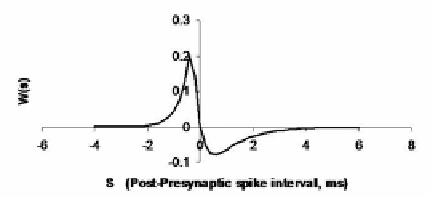Biomedical Engineering Reference
In-Depth Information
Figure 5
. Hebbian window function. Synaptic weight is increased in proportion to
W
(
s
). When
a presynaptic spike precedes a postsynaptic spike by less than about 2 ms,
W
(
s
) is positive;
when a presynaptic spike follows a postsynaptic spike by up to about 4 ms,
W
(
s
) is negative; it
is otherwise vanishingly small (see (8)).
Hebb layer units results in no net change of weight if the positive and negative
phases of the window function (Figure 5) integrate to zero.
Weights onto unit
i
that have fired recently are updated by an amount
w
ij
according to
w
ij
= F(
W
(
s
ij
) -
w
ij
),
[1]
where F is the learning rate,
s
ij
is the time interval between the firing of unit
i
and
j
, and
W
(
s
) is the function shown in Figure 5. Subtraction of the existing weight
w
ij
, ensures that weights are soft bounded, i.e., they do not grow without limits
(cf. the CPCA learning rule (18)). The repeated application of this rule leads to
stable weights but an excess of excitatory drive to the Hebb layer units. To
maintain an equitable balance between excitation and inhibition, weight nor-
malization is applied to make all the weights onto each unit sum to 1.
In the first phase of development, the vehicle traverses the field populated
by obstacles of various sizes, advancing continuously in space by an equal dis-
tance every simulation time step. For the present demonstration, the vehicle's
steering is disabled, so that it moves in a straight line, brushing against randomly
placed obstacles with its whiskers while its "retina" generates visual impulses
that have no effect on the Hebb layers. At this stage, we need only consider the
sustained units and their connections. The connections from the whiskers, which
are topographically mapped onto the Hebb layers (Figure 6A), are sufficiently
strong to fire the Hebb layer units reliably. The application of the learning rule
results in strengthening of the connections from those visual units that were ac-
tive shortly before the Hebb layer units spiked. Weights from the visual units are
continuously updated so that the sustained visual units come to map topographi-
cally over both Hebb layers. This is shown in the weight matrices of Figure 6B
by the diagonal of excitatory weights. The effect of weight normalization is to


